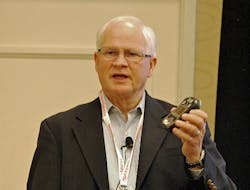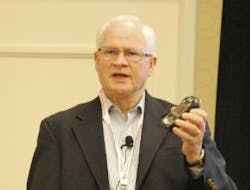“We now have a method to bring new data, new information, in from the edge.” Honeywell’s Tony Downes explained how connected personal gas detectors can increase worker safety and sometimes reveal issues that otherwise remain hidden.
Fixed and portable detectors protect workers from toxic gases at most plants And now, the portable, personal kind are even sending real-time data back to the control room. Alerting operators or emergency-response teams of noxious-gas exposure can save the lives of field workers and help to eliminate environmental incidents by tracking and trending data.
“This integration is critical when every second counts,” said Tony Downes, global process safety advisor in Honeywell’s Performance Materials and Technologies (PMT) division, during a presentation at this week’s Honeywell Users Group America 2019 in Dallas.
“We’re taking data from the edge, non-zero readings, and doing some smart stuff with it,” he explained. Honeywell’s integrated solution combines a connected, wearable ProRAE Guardian gas detection solution with Experion PKS visualization and alarming capabilities to deliver enhanced safety of field personnel.
“You can use LTE signals with mobile phones, or we can connect through an existing [wireless] network,” said Downes. Supported wireless technologies include Wi-FI; Bluetooth, which connects the gas detector to a mobile device for relay back to the control room; and Wi-Fi/cellular, which leverages a commercial mobile network when Wi-Fi is unavailable.
“The alarm information and the gas detector’s location are sent over the wireless network to Experion PKS back in the control room,” explained Downes. “The operator can call up the Experion graphic page to see the real-time location of the device on the site map. The operator can see if other workers are nearby, or inform the emergency-response team.”
The system continuously monitors for alarms and tracks data, including personnel location. And it leverages the alarm-management capabilities that are built into Experion. “There’s a lot of data coming back,” explained Downes. “If you bring it into the historian, you can do exposure analysis as well.”
Use cases for connectivity
Industrial accidents cost a lot of money, and there are still plenty of them. In 2012 and 2013, for example, the total value of the seven largest accidents in the hydrocarbon industry caused by fire or explosion exceeded $1 billion, said Downes.
In refineries, field workers might be exposed to hydrogen sulfide (H2S). “It’s a very dangerous gas,” said Downes. “In the field, you have a lot of people working by themselves these days. They’re an increased safety risk. You want to track where they are and what they’re exposed to. Any delay in notification mean you’re going to have a longer response time.”
Meanwhile, control-room operators don’t know what’s going on in the field unless they’re talking to the field personnel. A personal gas safety system with man-down detection can help rescue someone who’s been exposed and rendered unconscious.
Pattern analysis of non-zero readings can also help to identify hard-to-find leaks. For example, at a plant that generates nitrogen dioxide “we had spikes of NOx concentration, but zero readings in the same area,” he explained. “Turned out, some fumes escaped when vessels were discharging because we weren’t carrying the gases away fast enough. We had a more dramatic example with a feed tank where we lost a blower. I was wearing a gas detector, and it went off when I was above the tank.”
The Honeywell personal gas detection system offers more than simple integration, added Downes. “The tool brings standardization,” he explained. “We now have a method to bring new data, new information, in from the edge. Key gas detector data, such as GPS location, is automatically historicized, and the network architecture meets all safety and security guidelines.”
Because Honeywell sells the control systems and the gas detectors, it can put all the pieces together. “That reduces engineering efforts and implementation risk,” said Downes. “It gives you faster response and the opportunity to do more with the data that you’ve collected.”
About the Author
Mike Bacidore
Mike Bacidore

Leaders relevant to this article:

